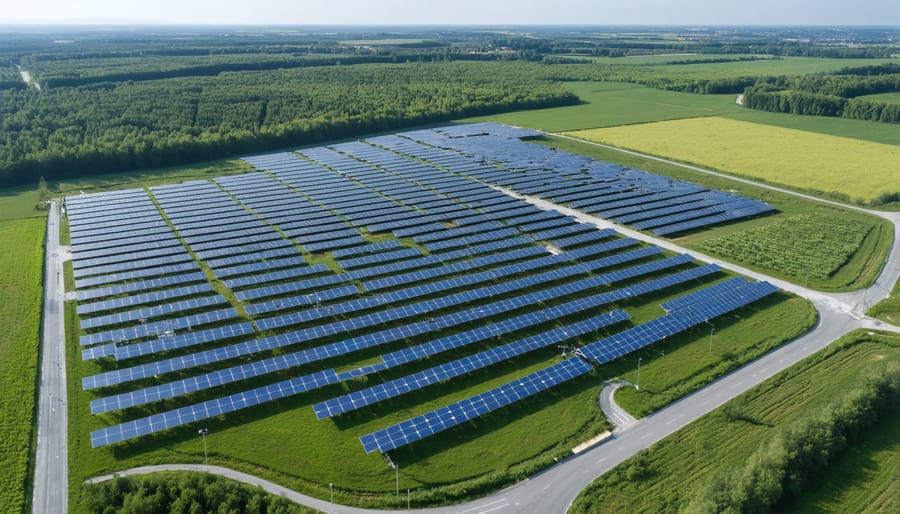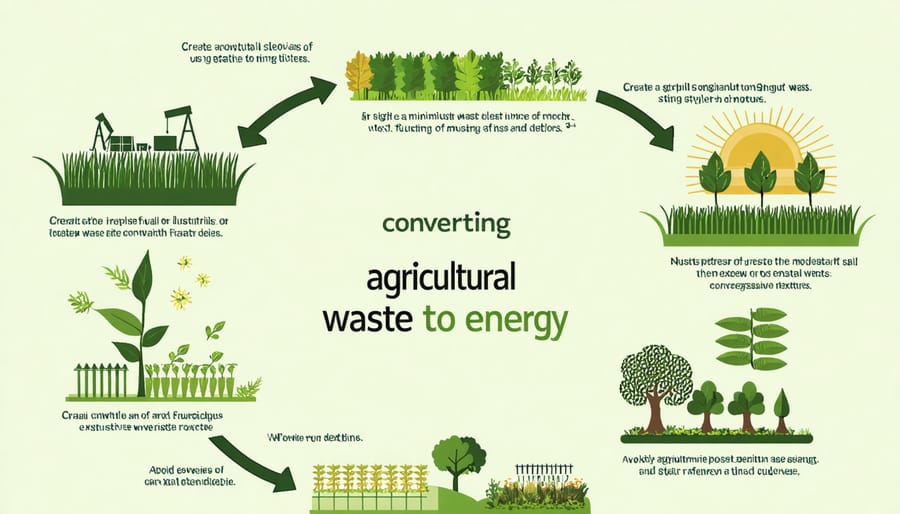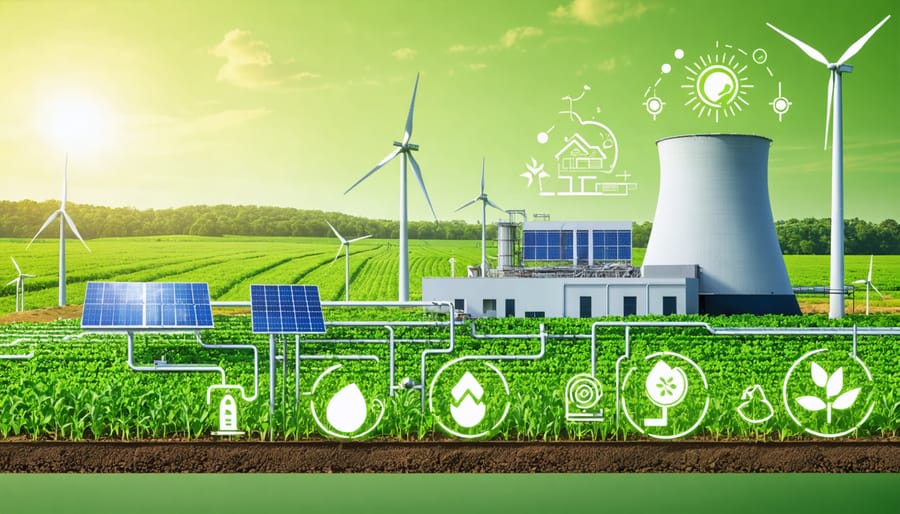Transforming Australia’s energy landscape takes a bold leap forward as Xcel Energy’s groundbreaking Integrated Resource Plan demonstrates how a circular bioeconomy can revolutionize our power grid. By committing to 80% renewable energy by 2030, Xcel’s strategic roadmap offers Australian utilities and policymakers a proven framework for sustainable energy transition. Their innovative approach to integrating bioenergy resources, particularly in agricultural regions, mirrors Australia’s unique potential for biomass utilization. This comprehensive plan, combining solar, wind, and bioenergy solutions, showcases how traditional energy providers can evolve into renewable energy powerhouses while maintaining grid reliability and affordability. For Australian stakeholders, Xcel’s success story provides crucial insights into managing the complexities of large-scale renewable integration, particularly in regional communities where bioenergy resources remain largely untapped. Their methodical approach to stakeholder engagement, technological innovation, and environmental stewardship offers a practical blueprint for Australia’s own renewable energy future.
Understanding Xcel Energy’s Integrated Resource Plan
Core Components and Targets
Xcel Energy’s Integrated Resource Plan sets ambitious targets for renewable energy transformation, aiming to achieve 80% carbon reduction by 2030 and complete carbon-free electricity generation by 2050. The plan’s core components focus on systematic retirement of coal-fired plants, with all facilities scheduled for closure by 2034.
The implementation timeline showcases a staged approach, beginning with substantial wind power expansion, targeting 7,000 megawatts of new wind capacity by 2030. Solar installations will follow, with plans to add 5,000 megawatts of utility-scale solar farms across service territories. Energy storage solutions feature prominently, with 2,500 megawatts of battery storage planned for integration by 2034.
Critical to the plan’s success is the development of advanced grid infrastructure and smart technology deployment. The resource mix prioritizes reliability through flexible generation assets, including natural gas facilities that can eventually transition to renewable natural gas or hydrogen fuel. Community engagement programs and distributed energy resources form essential components, ensuring broader participation in the clean energy transition while maintaining grid stability and affordability for consumers.
Bioenergy Integration Strategy
Xcel Energy’s resource plan strategically incorporates bioenergy as a crucial component of its renewable energy portfolio, recognizing the significant bioenergy integration benefits for grid stability and sustainability. The plan emphasizes utilizing organic waste streams from agriculture and forestry sectors, converting them into reliable baseload power generation while simultaneously addressing waste management challenges.
The strategy focuses on developing distributed bioenergy facilities near agricultural centers, creating local energy hubs that reduce transmission losses and strengthen community resilience. By implementing advanced anaerobic digestion technologies, these facilities can process multiple feedstock types, ensuring year-round operation and consistent energy production.
A standout feature of the plan is its commitment to circular economy principles, where biomass resources are fully utilized in a closed-loop system. This approach not only generates renewable energy but also produces valuable by-products such as biochar and organic fertilizers, supporting sustainable agriculture practices.
The integration strategy also includes smart grid technologies to optimize bioenergy plant operations, ensuring seamless coordination with other renewable sources like solar and wind, particularly during peak demand periods.

Circular Bioenergy Integration: Lessons for Australia
Agricultural Waste to Energy
In a groundbreaking initiative, Xcel Energy’s integrated resource plan recognizes the immense potential of agricultural waste as a sustainable power source. The plan emphasizes the transformation of farming byproducts into clean energy through advanced waste-to-energy conversion technologies, creating a win-win situation for both farmers and energy consumers.
The strategy focuses on utilizing abundant agricultural residues like crop stubble, livestock manure, and food processing waste. By partnering with local farming communities, Xcel Energy aims to establish a network of bioenergy facilities that can process these materials into reliable power sources. This approach not only addresses waste management challenges but also provides farmers with additional income streams.
What makes this initiative particularly promising is its circular economy approach. The process generates not only electricity but also valuable byproducts such as biochar and organic fertilizers, which can be returned to farmland to improve soil health. This creates a sustainable cycle that benefits both agriculture and energy production.
The plan includes pilot projects demonstrating how smaller-scale agricultural waste processing facilities can be integrated into existing farm operations. These facilities are designed to be scalable, allowing communities to start small and expand as capacity and demand grow. This practical approach ensures that the transition to bioenergy is both manageable and economically viable for farming communities.

Grid Integration Solutions
Xcel Energy’s innovative approach to grid integration demonstrates how modern power infrastructure can seamlessly accommodate bioenergy sources. By implementing smart grid integration solutions, they’ve created a flexible system that responds dynamically to varying energy inputs while maintaining grid stability.
The plan incorporates advanced monitoring systems and automated controls that enable real-time adjustment of power flow from bioenergy facilities. This sophisticated setup includes voltage regulation equipment, protective relaying, and communication systems that ensure smooth interaction between conventional power sources and bioenergy inputs.
Key technical features include bi-directional power flow capabilities, which allow excess bioenergy-generated power to be fed back into the grid when production exceeds local demand. The system employs adaptive grid management software that optimizes power distribution based on real-time demand patterns and available renewable resources.
To enhance reliability, the integration design includes advanced energy storage solutions and redundant systems that maintain grid stability during fluctuations in bioenergy production. The plan also addresses potential challenges such as voltage regulation and frequency control through sophisticated power electronics and smart inverter technologies.
These technical solutions demonstrate how traditional power infrastructure can be modernized to accommodate increasing amounts of bioenergy, providing valuable lessons for Australian utilities looking to enhance their renewable energy capabilities.
Environmental Benefits
Xcel Energy’s Integrated Resource Plan marks a significant milestone in the journey towards a cleaner energy future, projecting an impressive 85% reduction in carbon emissions by 2030 compared to 2005 levels. This ambitious target sets a new benchmark for utility companies worldwide and demonstrates the feasibility of large-scale emissions reduction in the power sector.
The plan’s environmental benefits extend beyond carbon reduction. By accelerating the retirement of coal-fired power plants and replacing them with renewable energy sources, Xcel Energy will significantly decrease other harmful emissions, including sulfur dioxide and nitrogen oxides. This transition will lead to improved air quality and better health outcomes for local communities.
A standout feature of the plan is its comprehensive approach to renewable energy integration. The proposed mix of wind, solar, and battery storage not only reduces environmental impact but also creates a more resilient power grid. This strategic combination helps maintain reliable service while minimizing the ecological footprint of energy generation.
The plan also emphasizes land and water conservation. By shifting away from water-intensive coal operations to renewable alternatives, Xcel Energy expects to reduce water consumption significantly. Additionally, the company’s commitment to responsible site selection for renewable energy facilities helps preserve natural habitats and minimize wildlife impact.
These environmental initiatives serve as a valuable blueprint for Australian energy providers, demonstrating how ambitious sustainability goals can be achieved while maintaining grid reliability and economic viability.
Implementation Roadmap for Australian Markets
Policy Framework Recommendations
To effectively implement lessons from Xcel Energy’s integrated resource plan in the Australian context, several key policy frameworks need consideration. First, the establishment of clear renewable energy targets at both state and federal levels would provide the necessary foundation for long-term planning. These targets should be accompanied by specific timelines and measurable outcomes, similar to Xcel’s approach of setting interim milestones.
A critical policy recommendation is the introduction of streamlined permitting processes for renewable energy projects, particularly in regional areas where bureaucratic hurdles often delay implementation. This should be coupled with incentive mechanisms that encourage private sector investment in renewable infrastructure, such as feed-in tariffs and tax benefits for clean energy initiatives.
The development of comprehensive grid modernization policies is essential to support the integration of diverse energy sources. This includes updating regulations to accommodate smart grid technologies and energy storage solutions, while ensuring grid stability and reliability during the transition period.
To foster innovation and local manufacturing, policies should support research and development in renewable technologies through targeted funding programs and public-private partnerships. Additionally, workforce development policies need to focus on training programs that prepare workers for the renewable energy sector.
Community engagement frameworks should be mandated within energy planning processes, ensuring local stakeholders have a voice in project development. This approach has proven successful in Xcel’s territories and could be adapted for Australian communities.
Finally, carbon pricing mechanisms and emissions reduction schemes should be strengthened to create economic incentives for transitioning to cleaner energy sources, while protecting vulnerable consumers through appropriate support measures.
Industry Collaboration Models
Xcel Energy has pioneered innovative collaboration models with the agricultural sector, creating mutually beneficial partnerships that strengthen both energy production and farming communities. Their approach centers on developing strategic alliances with farmers and agricultural businesses to source biomass materials while ensuring sustainable farming practices.
A standout feature of their collaboration strategy is the “Farm-to-Energy” program, where farmers receive guaranteed income for dedicating portions of their land to energy crops while maintaining food production. This model has proven particularly successful in regions with mixed farming operations, providing farmers with diversified income streams and Xcel Energy with reliable biomass supplies.
The company has also established regional agricultural cooperatives that serve as biomass collection and processing hubs. These facilities act as intermediaries between individual farmers and power plants, streamlining the supply chain and reducing transportation costs. Farmers benefit from shared resources and expertise, while Xcel Energy maintains consistent fuel quality standards.
Educational partnerships form another crucial component, with Xcel Energy providing training and technical support to farmers transitioning to energy crop production. This knowledge-sharing initiative has helped build trust and long-term relationships with the agricultural community while improving biomass yield and quality.
The success of these collaboration models has led to the development of “circular economy zones” where agricultural waste becomes valuable energy resources. This approach has not only reduced waste management costs for farmers but has also created new revenue opportunities through the sale of agricultural by-products for energy generation.
Looking ahead, Xcel Energy continues to refine these partnership models, focusing on digital integration and smart farming practices to optimize biomass production and collection efficiency.

Technology Transfer Opportunities
Xcel Energy’s integrated resource plan offers several promising technology transfer opportunities that could benefit Australia’s energy transition. The plan’s innovative approach to combining solar, wind, and battery storage systems presents adaptable solutions for Australia’s diverse geographic regions.
Of particular interest is Xcel’s advanced grid management system, which could be modified to suit Australia’s National Electricity Market (NEM). This technology enables seamless integration of multiple renewable energy sources while maintaining grid stability – a crucial consideration for Australia’s vast network infrastructure.
The plan’s smart meter rollout strategy provides valuable insights for Australian utilities looking to enhance consumer engagement and demand management. These technologies can be readily adapted to Australian households, helping consumers better understand and control their energy usage while supporting grid reliability.
Another transferable element is Xcel’s battery storage implementation framework. With modifications to account for Australia’s unique climate conditions, this approach could enhance the reliability of renewable energy systems, particularly in remote communities and mining operations.
The plan’s innovative demand response programs offer valuable lessons for Australian energy retailers. These programs can be customized to suit local consumer behaviors and market structures, promoting more efficient energy use during peak periods.
Most importantly, Xcel’s digital transformation initiatives provide a blueprint for Australian utilities to modernize their operations. This includes advanced analytics for asset management and predictive maintenance systems that could significantly improve service reliability across Australia’s energy network.
Xcel Energy’s Integrated Resource Plan stands as a beacon of progress in the renewable energy transition, offering valuable lessons for Australia’s own energy future. The comprehensive approach to balancing reliability, affordability, and sustainability demonstrates how large-scale utilities can successfully navigate the path to clean energy while maintaining grid stability.
The plan’s commitment to achieving 80% carbon reduction by 2030 and 100% carbon-free electricity by 2050 sets an ambitious yet achievable benchmark that Australian energy providers can aspire to. Key takeaways include the importance of strategic phase-outs of coal-fired plants, significant investments in wind and solar infrastructure, and the critical role of energy storage solutions in managing intermittent renewable sources.
Looking ahead, the success of Xcel Energy’s plan suggests a promising future for similar initiatives in Australia. The emphasis on stakeholder engagement, careful planning of transmission infrastructure, and innovative approaches to grid modernization provides a valuable roadmap for our own energy transition.
As Australia continues to develop its renewable energy capacity, the lessons learned from Xcel’s experience can help accelerate our progress toward a sustainable energy future. The plan’s flexible approach to incorporating new technologies and adapting to changing market conditions demonstrates the importance of building resilience and adaptability into long-term energy planning.
This forward-thinking strategy reinforces the vital role of comprehensive resource planning in achieving ambitious clean energy goals while maintaining reliable and affordable power for all consumers.

